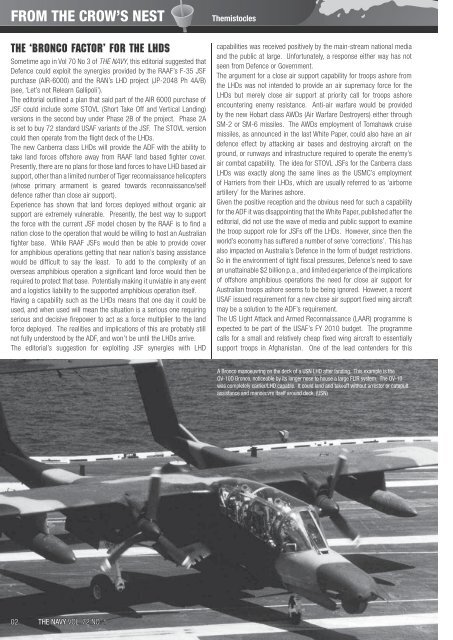JAN-MAR 2010 VOL 72 No1 - Navy League of Australia
JAN-MAR 2010 VOL 72 No1 - Navy League of Australia
JAN-MAR 2010 VOL 72 No1 - Navy League of Australia
You also want an ePaper? Increase the reach of your titles
YUMPU automatically turns print PDFs into web optimized ePapers that Google loves.
FROM THE CROW’S NEST<br />
THE ‘BRONCO FACTOR’ FOR THE LHDS<br />
Sometime ago in Vol 70 No 3 <strong>of</strong> THE NAVY, this editorial suggested that<br />
Defence could exploit the synergies provided by the RAAF’s F-35 JSF<br />
purchase (AIR-6000) and the RAN’s LHD project (JP-2048 Ph 4A/B)<br />
(see, ‘Let’s not Relearn Gallipoli’).<br />
The editorial outlined a plan that said part <strong>of</strong> the AIR 6000 purchase <strong>of</strong><br />
JSF could include some STOVL (Short Take Off and Vertical Landing)<br />
versions in the second buy under Phase 2B <strong>of</strong> the project. Phase 2A<br />
is set to buy <strong>72</strong> standard USAF variants <strong>of</strong> the JSF. The STOVL version<br />
could then operate from the flight deck <strong>of</strong> the LHDs.<br />
The new Canberra class LHDs will provide the ADF with the ability to<br />
take land forces <strong>of</strong>fshore away from RAAF land based fighter cover.<br />
Presently, there are no plans for those land forces to have LHD based air<br />
support, other than a limited number <strong>of</strong> Tiger reconnaissance helicopters<br />
(whose primary armament is geared towards reconnaissance/self<br />
defence rather than close air support).<br />
Experience has shown that land forces deployed without organic air<br />
support are extremely vulnerable. Presently, the best way to support<br />
the force with the current JSF model chosen by the RAAF is to find a<br />
nation close to the operation that would be willing to host an <strong>Australia</strong>n<br />
fighter base. While RAAF JSFs would then be able to provide cover<br />
for amphibious operations getting that near nation’s basing assistance<br />
would be difficult to say the least. To add to the complexity <strong>of</strong> an<br />
overseas amphibious operation a significant land force would then be<br />
required to protect that base. Potentially making it unviable in any event<br />
and a logistics liability to the supported amphibious operation itself.<br />
Having a capability such as the LHDs means that one day it could be<br />
used, and when used will mean the situation is a serious one requiring<br />
serious and decisive firepower to act as a force multiplier to the land<br />
force deployed. The realities and implications <strong>of</strong> this are probably still<br />
not fully understood by the ADF, and won’t be until the LHDs arrive.<br />
The editorial’s suggestion for exploiting JSF synergies with LHD<br />
Themistocles<br />
capabilities was received positively by the main-stream national media<br />
and the public at large. Unfortunately, a response either way has not<br />
seen from Defence or Government.<br />
The argument for a close air support capability for troops ashore from<br />
the LHDs was not intended to provide an air supremacy force for the<br />
LHDs but merely close air support at priority call for troops ashore<br />
encountering enemy resistance. Anti-air warfare would be provided<br />
by the new Hobart class AWDs (Air Warfare Destroyers) either through<br />
SM-2 or SM-6 missiles. The AWDs employment <strong>of</strong> Tomahawk cruise<br />
missiles, as announced in the last White Paper, could also have an air<br />
defence effect by attacking air bases and destroying aircraft on the<br />
ground, or runways and infrastructure required to operate the enemy’s<br />
air combat capability. The idea for STOVL JSFs for the Canberra class<br />
LHDs was exactly along the same lines as the USMC’s employment<br />
<strong>of</strong> Harriers from their LHDs, which are usually referred to as ‘airborne<br />
artillery’ for the Marines ashore.<br />
Given the positive reception and the obvious need for such a capability<br />
for the ADF it was disappointing that the White Paper, published after the<br />
editorial, did not use the wave <strong>of</strong> media and public support to examine<br />
the troop support role for JSFs <strong>of</strong>f the LHDs. However, since then the<br />
world’s economy has suffered a number <strong>of</strong> serve ‘corrections’. This has<br />
also impacted on <strong>Australia</strong>’s Defence in the form <strong>of</strong> budget restrictions.<br />
So in the environment <strong>of</strong> tight fiscal pressures, Defence’s need to save<br />
an unattainable $2 billion p.a., and limited experience <strong>of</strong> the implications<br />
<strong>of</strong> <strong>of</strong>fshore amphibious operations the need for close air support for<br />
<strong>Australia</strong>n troops ashore seems to be being ignored. However, a recent<br />
USAF issued requirement for a new close air support fixed wing aircraft<br />
may be a solution to the ADF’s requirement.<br />
The US Light Attack and Armed Reconnaissance (LAAR) programme is<br />
expected to be part <strong>of</strong> the USAF’s FY <strong>2010</strong> budget. The programme<br />
calls for a small and relatively cheap fixed wing aircraft to essentially<br />
support troops in Afghanistan. One <strong>of</strong> the lead contenders for this<br />
A Bronco manoeuvring on the deck <strong>of</strong> a USN LHD after landing. This example is the<br />
OV-10D Bronco, noticeable by its longer nose to house a large FLIR system. The OV-10<br />
was completely carrier/LHD capable. It could land and take<strong>of</strong>f without arrestor or catapult<br />
assistance and manoeuvre itself around deck. (USN)<br />
02 THE NAVY <strong>VOL</strong>. <strong>72</strong> NO. 1

















